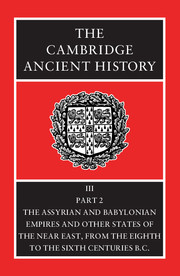Book contents
- Frontmatter
- Contents
- List of maps
- List of text-figures
- Preface
- PART I ASSYRIA AND BABYLONIA
- PART II THE EASTERN MEDITERRANEAN AND THE BLACK SEA
- 29 Israel and Judah from the coming of Assyrian domination until the fall of Samaria, and the struggle for independence in Judah (c. 750–700 B.C.)
- 30 Judah until the fall of Jerusalem (c. 700–586 B.C.)
- 31 The Babylonian Exile and the restoration of the Jews in Palestine (586–c. 500 B.C.)
- 32 Phoenicia and Phoenician colonization
- 33 Scythia and Thrace
- 34 Anatolia
- 34a The native kingdoms of Anatolia
- 34b Anatolian languages
- 35 Egypt: the Twenty-fifth and Twenty-sixth Dynasties
- Chronological Table
- Note on The Calendar
- BIBLIOGRAPHY
- Index
- Map 11: Phoenician and Punic sites in Spain
- Map 13: Scythia
- Map 14: Thrace
- References
34b - Anatolian languages
from 34 - Anatolia
Published online by Cambridge University Press: 28 March 2008
- Frontmatter
- Contents
- List of maps
- List of text-figures
- Preface
- PART I ASSYRIA AND BABYLONIA
- PART II THE EASTERN MEDITERRANEAN AND THE BLACK SEA
- 29 Israel and Judah from the coming of Assyrian domination until the fall of Samaria, and the struggle for independence in Judah (c. 750–700 B.C.)
- 30 Judah until the fall of Jerusalem (c. 700–586 B.C.)
- 31 The Babylonian Exile and the restoration of the Jews in Palestine (586–c. 500 B.C.)
- 32 Phoenicia and Phoenician colonization
- 33 Scythia and Thrace
- 34 Anatolia
- 34a The native kingdoms of Anatolia
- 34b Anatolian languages
- 35 Egypt: the Twenty-fifth and Twenty-sixth Dynasties
- Chronological Table
- Note on The Calendar
- BIBLIOGRAPHY
- Index
- Map 11: Phoenician and Punic sites in Spain
- Map 13: Scythia
- Map 14: Thrace
- References
Summary
THE PHRYGIAN LANGUAGE
The Greeks had undoubtedly known of the Phrygians for an extremely long time. Certain writers, such as Herodotus and Hipponax, have left us some indication of the nature of their language, and Hesychius' Lexicon has provided us with glosses of unequal value. It is, however, largely from epigraphic sources that our knowledge of Phrygian is derived. These texts may be divided into two groups, separated in time by several centuries and originating from relatively different geographical regions. There can, however, be no doubt that we are dealing with two successive stages – separated by (for us) a long interruption – in the development of one and the same language.
The ancient, or Palaeo-Phrygian, texts are distributed over a vast area: Phrygia proper, including in particular Midas City (1 F etc.; Pls. Vol., pl. 241); Bithynia, where we have the longest extant text, that of Germanos; central Galatia, with Gordium, and eastern Galatia, with Bogazköy, Kalehisar, etc.; and Cappadocia, with the black stone of Tyana (19 F). For the most part, these are texts carved on some rock-cut facades of cult-places (in the west) and various graffiti on vases, the latter being particularly interesting on account of the script used (Fig. 48). There are, in all, close on 50 inscriptions on stone and over 170 graffiti. It is mainly for the graffiti that it has been possible to establish a chronological sequence. Many of the Gordium texts date from the fifth and fourth centuries, some even from the third; one of them, however, can be dated as far back as 750 B.C. (or even before), and the specimens from the Great Tumulus around 720.
- Type
- Chapter
- Information
- The Cambridge Ancient History , pp. 666 - 676Publisher: Cambridge University PressPrint publication year: 1992
References
- 3
- Cited by



